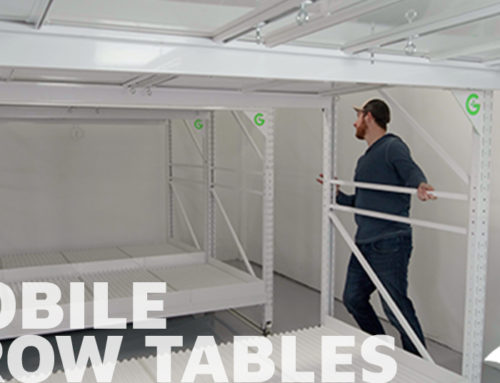Cannabis cultivation isn’t just a hobby anymore. Today, growing cannabis has become an agricultural science as well as a business. Over the last few decades, as cannabis cultivation has become legal in different states throughout the U.S., growers have continuously been tinkering with the best possible ways to produce healthy plants. The goal being, what’s the most efficient way to produce the product?
Recently, vertical growing has begun to catch the eye of commercial cultivators. Both small scale and large scale operators struggle to balance three things when producing cannabis:
- Space issues
- Energy issues
- Money issues
By many accounts, taking a vertical farming approach may help minimize these issues for operators. However, no great idea is free of drawbacks. Vertical growing often has a larger start-up cost, controlling the growing environmentals can be more difficult, and highly-knowledgeable experts are needed to ensure the plants develop properly under these unique conditions.
If you are new to the concept of vertical growing, the simple principle is to maximize square footage by having plants grow on stacked shelving units or even on walls. This allows for more plants per square foot, and in addition, gives growers the ability to set up more resourceful hydroponic, aeroponic, or soilless grow methods.
In the long-term, vertical growing is a positive investment for companies looking to increase efficiency and expand production metrics.
Why Space, Energy, and Money Issues Improve With Vertical Farming
As mentioned before, nearly every cannabis cultivation company faces issues when it comes to available space, energy consumption, and overhead costs. These three problems often slow down cannabis operators from taking that “next step” within the industry. Numerous commercial growers have switched to a vertical growing strategy and their first-hand results have shown that the only way forward — is up!
Limited Growing Space
Maybe the biggest issue facing growers is the lack of space. You can only grow what the room can hold. Most cannabis demand stems from urban areas where rent is higher and space is limited. This means buying or renting warehouse after warehouse to increase your plant yield isn’t the most realistic option.
Vertical growing enables businesses to immediately double, triple, or even quadruple their yield numbers simply by changing the ergonomic layout of your planting. It is important to note here that two forms of vertical growing exist: stacked vertical and truly vertical.
Stacked vertical growing involves moveable shelves that have different rack levels that hold the plants. This way the plants still grow horizontally, but take up dramatically less floor space. True vertical growing is a system in which cannabis plants grow outward from a vertical column or wall, and also greatly reduce the amount of used floor space.
The introduction of either method allows businesses to quickly increase the square footage of production canopy, and more efficiently use their limited flooring space.
Expensive and Inconsistent Energy
It’s no secret that cannabis plants require very specific environmental conditions to thrive. Achieving and maintaining the right temperature, humidity, vapor pressure deficit, lighting intensity and spectrum, aeration, and watering conditions is critical to producing usable plants. When cannabis plants are set up in a non-vertical growing strategy, a lot of energy is often wasted.
The distance from a light source to plant hurts plant growth. High-pressure sodium (HPS) lights run hot, can be expensive in the long run when replacing bulbs, and are incapable of producing uniform light source for the plants. This causes them to be an inefficient energy option that has to be fixed by adding more HVAC to accommodate the heat being generated by the lamps.
With vertical growing, LED lights can be subbed-in for HPS lights. LEDs can be installed right beside or above the plants and provide a consistent and uniform light source for every plant. Additionally, vertical growing allows for easier segmentation of your plants giving you greater control over watering, airflow, and temperature. With a vertical strategy, growers notice greater management over their plants and a more efficient way of delivering the proper conditions.
Financial Ceilings
Cannabis isn’t a cheap product to grow. Many operators have big plans but need a phased approach to reach those plans due to funding restrictions. Switching to vertical farming can help accelerate your business development by providing higher yield counts, more efficient spending, and greater bottom-line profitability. If your business growth isn’t matching your current timeline, switching to a vertical growth plan might be the deciding factor that helps elevate your cultivation process to the next level. If you plan for it from the beginning, it’s easy to add additional tiers at later phases of your business cycle, allowing you to truly grow into your space as your business grows.
Want to Start Vertical Growing at Your Business?
Grow Glide came to the market with a versatile and fully functional cultivation system. With the highest strength rating per shelf on the market, our cultivator solutions are designed from the ground up to fill any needs with high-quality material and design for maximizing available real estate.
We believe our system is the best on the market and does what we were always looking for: a first-class benching system without the luxury price tag. Ready to start growing? Contact us today!












